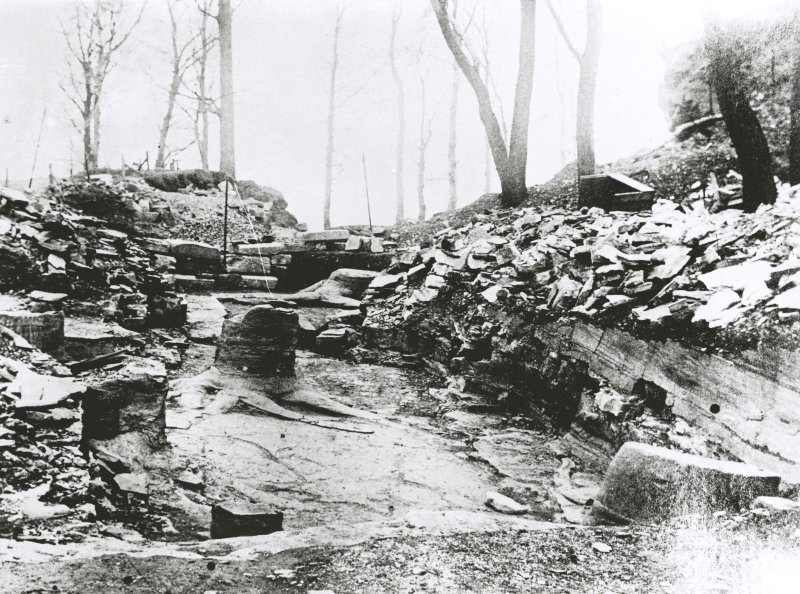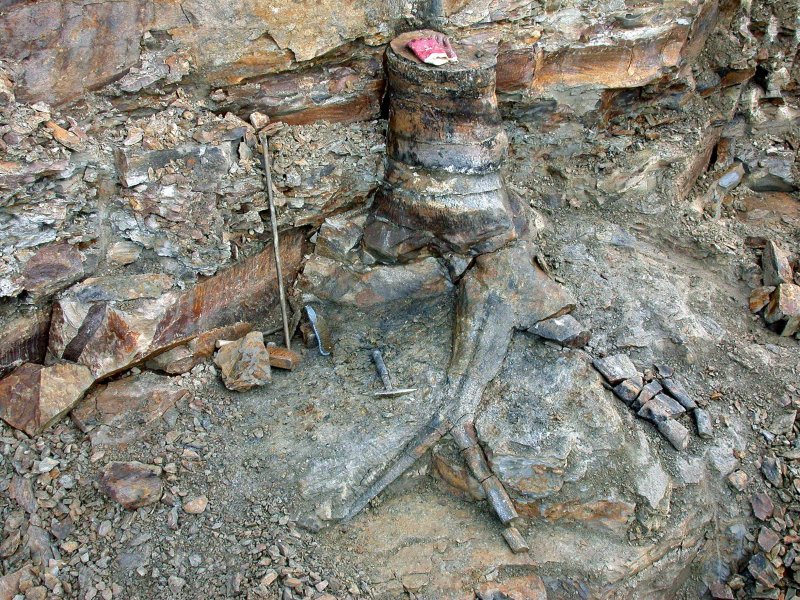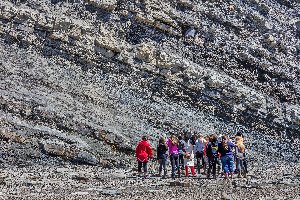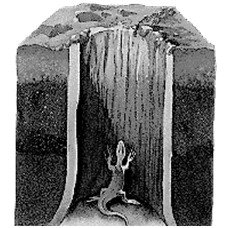
Stigmaria
and stumps of clubmoss trees II I
|
|
|
 Fig.
12. Photo from 1887 of The Fossil Grove, the petrified 'forest' of
stumps of clubmoss trees in Victoria Park in Glasgow. Nowadays part of
it is covered and can be visited. |
Complete root systems
More or less complete Stigmaria
systems have relatively rarely survived. A well-known example is the
one in museum Am Schölerberg in Osnabrück (Fig.13). It was discovered
in 1886 in the Piesberg and put together in parts. The diameter of the
system is about 8 m and it weighs three tons.
A very beautiful root system was (also) found in 1886 in a quarry in Clayton (Yorkshire) by Prof. Williamson. He had it excavated and set up at his own expense in the Manchester Museum (fig. 14). The original diameter was 9 m but due to lack of space it is limited to 6 m in the museum.
Thomas
& Seyfullah (2015) describe a fossil 'forest' found in a quarry in
Brymbo, North Wales. It consists of 20 upright trunks up to 1.5 m in
diameter and up to 2.5 m high. However, these don't have preserved Stigmaria.
In a somewhat higher layer a fairly complete root system has been found
which has been completely uncovered and from which they were able to
draw conclusions about the way in which this system has been preserved.
The twenty tree trunks preserved without Stigmaria
were found in a 2 m thick layer of shale/claystone that turned towards
the top into the slightly less fine-grained siltstone. The trunk with
the Stigmaria was found in a
layer of sandstone. It has a diameter of about 5 m and the trunk is 50
cm thick and 1.7 m high. The root system has been completely excavated
to preserve it (Fig. 15). A loose Stigmaria axis of 8 m long was found in the same layer.
How
does such a petrified 'forest' arise? It is generally assumed that the
decaying parts of the trunk and root system are filled with sediment
that subsequently hardens. However, the question is how the shape of
the trunk and the underground parts are preserved in this process. In
the Brymbo fossil a thin hard brown layer of iron oxide (FeO(OH)) was
found on the outside. This mineral is also often found at the bottom of
lakes and creeks and is formed when ferrous water comes into contact
with oxygen from plant cells. This layer can ensure that the shape of
trunk and Stigmaria remains
intact when the interior decays and is replaced by sediment. The ends
of the root systems are almost always missing, which is almost
certainly due to the fact that they consisted of softer material and
therefore decayed faster.
This process may also have occurred in some other systems.
 Fig. 15. Stigmaria system of Brymbo. From Thomas & Seyfullah (2015). Photo: B. Thomas. |
 Fig. 16. The layers from the Carboniferous near Joggins (Nova Scotia, Canada). A group of excursionists look at a tree stump in the deposit. Photo: L. Nichol. |
 Joggins
Joggins
At Joggins in Nova Scotia in
the far north-east of Canada, the process has certainly been different.
For almost two centuries, the coast near the town of Joggins has been a
famous site for carboniferous clubmoss tree trunks and stumps (Fig.
16). Due to tidal differences of up to 12 meters and violent storms and
rains, the cliffs there crumble regularly. New trunks constantly
emerge, which disappear in an average of three years due to erosion.
What has made the place especially famous is the fact that remains of
carboniferous quadrupeds have been found in some of these trunks. The
most famous is the Hylonomus lyelli,
the oldest reptile found so far. The 20 cm long animal was discovered
by Dawson in 1852, and described by him in 1860. Not until 100 years
after the discovery it was discovered to be a reptile.
The famous geologist Lyell was collecting there together with Dawson.
Due
to rising and falling sea levels in the Late Carboniferous, the marshes
drowned from time to time and were re-formed. The flood plains were
covered by enormous mudflows, with the present forests being embedded
in sediment. That the sedimentation at Joggins was very fast is shown
by the fact that the deposits of 900 meters were formed in one million
years. After a short period of time, the mud hardened and encircled the
lower few metres of the clubmoss trees. The soft material, which
the trunks largely consisted of, rotted away and holes came into existence
in the ground. It has always been assumed that animals fell in, died
and were embedded in the next muddy stream. But a new theory states
that the animals may have used the hollow trunk holes as hiding or
living places.
The Joggins coast was placed on the World Heritage list in 2008.
Probably the formation of fossil 'forests' went in most cases comparably to Joggins, albeit in a more moderate form because there are no other known places where fossil animals have been found in the trunks.
Coal balls, Stigmaria
systems and fossil 'forests' of tree stumps tell a lot about the
structure and growth of the clubmoss trees in the Carboniferous. The
trees stood quite close together, with extensive root plates anchored
in the swampy ground. And although there was a lot of light on the
ground, undergrowth was only in open, often higher areas.
Mudslides, caused by faster soil subsidence or rising sea levels,
destroyed the forest but bedded the lower parts of the trunks and the
root systems. In the hardening sediments the trunks and Stigmaria's
rotted away, creating cavities that were later filled with new
sediment. Because there was a discontinuity between the casts of the
tree parts and the surrounding sediment, the forms could continue to
exist for hundreds of millions of years.
Literature
Calder, J.H.;
Gibling,
M.R.; Scott, Andrew C.; Davies, S.J.; Herbert, B.L., 2006 A
fossil lycopsid forest succession in the classic Joggins section of
Nova Scotia: paleoecology of a disturbance-prone Pennsylvanian wetland.
In
Wetlands through Time. ed. S.J. Greb;
W.A. DiMichele. Vol. 399 Geological Society of America Special
Publication, 169-194.
Falcon-Lang H.J., Gibling
M.R., Grey M. ,2010. Classic localities explained 4: Joggins, Nova
Scotia. Geol
Today 26(3):108–114
Hetherington, A.J.,
Berry, C.M. , Dolan, L., 2016. Networks of highly branched
stigmarian
rootlets developed on the first giant trees. Proc. Natl. Acad. Sc.i
USA,
113(24): 6695–6700.
Stewart W. A., 1947. A
comparative study of stigmarian appendages and Isoetes roots. Am
J Bot. 34(6):315–324.
Taylor, T.N., Taylor E.L. & Krings, M.,
2009. Paleobotany: The Biology and Evolution
of Fossil Plants [2nd Ed]. New
York: Academic Press.
Thomas,
B, 2016. A Carboniferous Fossil Forest in North Wales: Problems and
Potentials
Associated with Developing and Conserving a ‘Soft-Rock’ Site.
Geoheritage, Vol.
8, Issue 4, 401–406.
Thomas, B,
Seyfullah,
L.J., 2015. Stigmaria Brongniart: a
new specimen from Duckmantian (Lower Pennsylvanian) Brymbo (Wrexham,
North
Wales) together with a review of known casts and how they were
preserved. Geol. Mag., 152(3): 858–870.